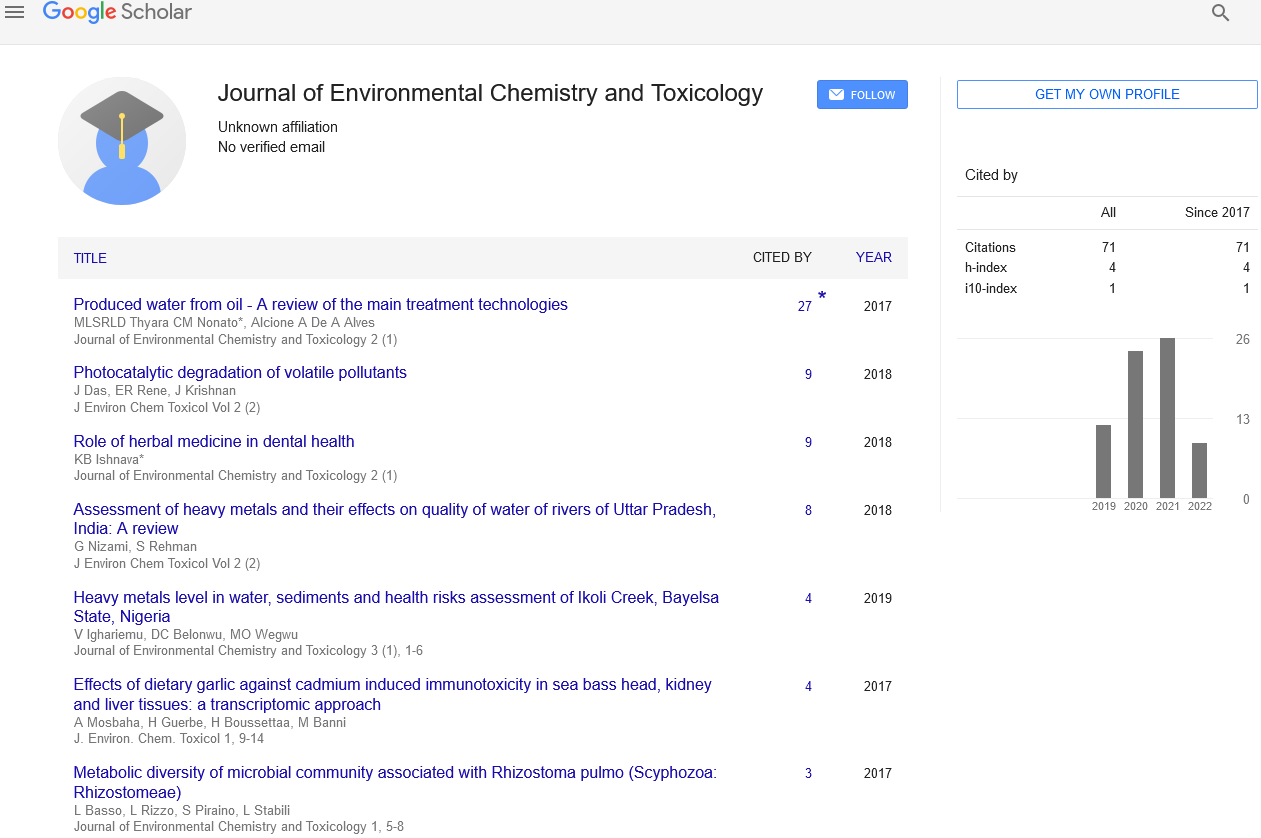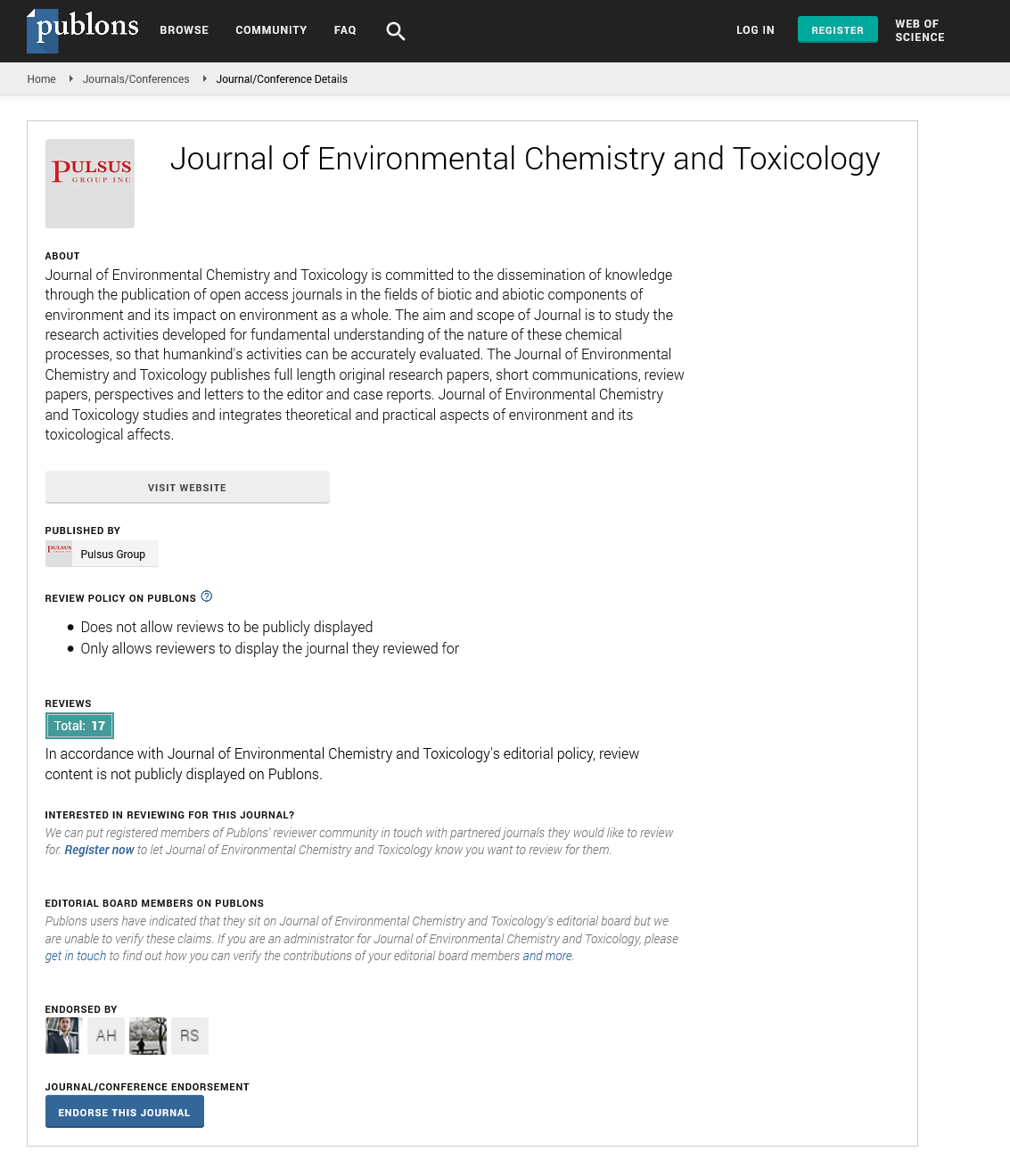Marine environment surveillance
Received: 04-May-2022, Manuscript No. PULJECT-22-4933; Editor assigned: 12-May-2022, Pre QC No. PULJECT-22-4933(PQ; Accepted Date: May 20, 2022; Reviewed: 14-May-2022 QC No. PULJECT-22-4933; Revised: 16-May-2022, Manuscript No. PULJECT-22-4933(R); Published: 24-May-2022, DOI: pulject.2022.6(3);23-24
This open-access article is distributed under the terms of the Creative Commons Attribution Non-Commercial License (CC BY-NC) (http://creativecommons.org/licenses/by-nc/4.0/), which permits reuse, distribution and reproduction of the article, provided that the original work is properly cited and the reuse is restricted to noncommercial purposes. For commercial reuse, contact reprints@pulsus.com
Abstract
During the Antarctica research trip, environmental monitoring and assessment of the marine environment of the Indian and Southern Oceans is a major opportunity. It is possible to assess the distribution of main and minor element concentrations in surface seawater samples. Seawater samples must be collected from several pre-determined sampling locations in the Indian and Southern Oceans,and analyzed for heavy metals such as copper (Cu), lead (Pb), cadmium (Cd), zinc (Zn), nickel (Ni), chromium(Cr). Using inductively coupled plasma optical emission spectroscopy, the amounts of heavy metals Cu, Pb, Cd, Zn, Ni, Cr, and other significant elements such as sodium, potassium, calcium, magnesium, and boron were determined in selected seawater samples (ICP-OES).
Key Words
Seawater, Antarctica, Southern ocean
Introduction
Due to a lack of strong research setups and networks, processes Dthat govern the distributions and variability of trace elements, particularly metals, in coastal zones remain little understood. Most continental shelf waters have only enough information to show that near shore trace metal concentrations are often higher than open ocean waters at similar depths, indicating both natural and anthropogenic inputs at the ocean's edge. Data limitations imposed by tedious and delayed analysis procedures and methodologies for metals in seawater contribute to our limited understanding of chemical variability in coastal waters. In certain less researched and pure regions, such as the southern seas, these understandings are less widespread. With the exception of iron, our understanding of trace element biogeochemical cycles and their impact on the Southern Ocean's oceanic ecosystem is relatively restricted. Certain trace metals, such as cadmium (Cd) and copper (Cu), show nutrient-like profiles, indicating their involvement in biological cycles. Other metals, on the other hand, show a scavenged tendency like lead or act conservatively like uranium. At high latitudes, elements like manganese (Mn) might be termed hybrid-type metals because their distribution is influenced by biological uptake and scavenging activities. Furthermore, the marine behavior of other trace metals, such as silver (Ag), is still unknown, with scant data on Ag distributions in the worldwide ocean, particularly in the Southern Ocean. Hemisphere. Despite significant progress in understanding the ecological role of trace metals and their geochemical dynamics in the ocean, basic knowledge of their biogeochemical cycles remains missing. For example, for the Southern Ocean, there are only a few thorough datasets for Mn, and Cu, Cd, and Pb. External trace metal supplies to the southeastern Atlantic and Southern Ocean are not well constrained. In addition to atmospheric depositions to surface waters and inputs from hydrothermal vents to bottom waters, recent research reveals the importance of advection of water masses enriched in trace metals following contact with continental margins. The connection of trace and major nutrient cycles, such as the correlations between Cd and phosphate (PO4) in the Southern Ocean, shows that the removal of trace elements is taking place. Uptake of trace nutrients by phytoplankton in surface waters, followed by sinking and re mineralization in deep waters our understanding of this interaction, however, is yet confined to a few trace elements. There has been some published research on heavy metals in the Antarctic region's snow, ice, seas, atmosphere, soil, rock, and wildlife. However, analytical data on the Antarctic marine ecosystem, including seawater and biological materials, is limited, making it difficult to comprehend heavy metal distribution and bioaccumulation processes in depth. The Antarctic maritime ecosystem, particularly beyond the Antarctic Convergence, is stable and old, with a higher percentage of endemic species than other ecosystems, making it simple in comparison. The Antarctic area is a somewhat isolated environment because atmospheric mixing between north and south of the Antarctic Convergence is quite slow. Seawater, inland water, and other aquatic systems play a significant role in the biogeochemical cycle. Despite the fact that dissolved levels are usually in the trace range, they are important because they reach the food chain and interact with suspended particles and sediments mostly through the dissolve state.
Toxic metals, such as Cd, Pb, Ni, Cr, and others, are gaining importance in environmental study due to their biological nondegradability. Chronic toxicity is caused by their buildup in human essential organs. When excessive amounts of heavy metals are present in saltwater, they become poisonous and represent a harm to the ecology. As a result, constant efforts have been made to assess the impact of these metals on fauna. Despite their low quantities, trace metals in seawater have a significant impact on marine biogeochemistry and serve as crucial markers of fundamental processes. Chemical analysis of seawater, on the other hand, is particularly problematic due to lower concentrations of many of the analytes of interest and a general lack of understanding of speciation within the matrix. Because total dissolved solids can interfere with proper detection of ambient trace metal levels, most classic analytical methods are inadequate. A few researchers are working on monitoring and assessment projects, particularly in the area of metal detection in water bodies, and has done some work in this area. The goal of this study is to determine, analyze, and forecast the impact of growing anthropogenic activities on Antarctica's environmental components. The data generated could show some geogenic and anthopogenic interactions in natural aquatic ecosystems. The choice of such a large sampling stretch, as well as the sampling and analytical work that will be carried out, will reveal some relationships between certain components and their availability, migration, and distribution in the earth ecosystem. On the other hand, the results of this work will compensate for and attempt to fill in the gaps in existing research in this field of analytical research.






